Decision Spread
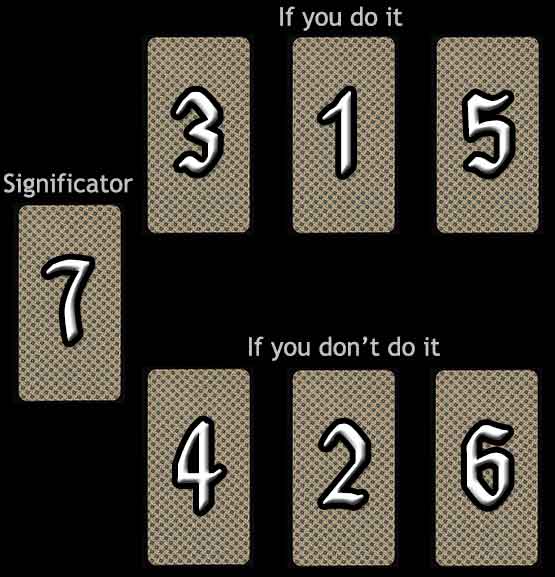
Difficulty: Easy
This simple but highly useful spread calls for a question to be asked in this format:
'What happens if I do (X), and what happens if I do not do (X)?'
Please note that it should not be viewed as a decision between two different options, but about whether a single option should be exercised or not. A second option would call for a separate reading.
Card #7 is the significator, the overall theme of the query.
Cards #3, #1, & #5 represent the chronological sequence of events that occurs if the reader chooses to do (X).
Cards #4, #2, & #6 represent the chronological sequence of events that unfolds if the reader chooses not to do (X).
Your Decision Reading
The Significator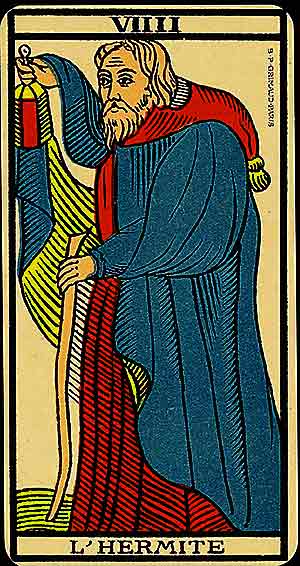 VIIII – The Hermit (L'Hermite) |
Outcome if you do it: | ||
 XXI – The World (Le Monde) |
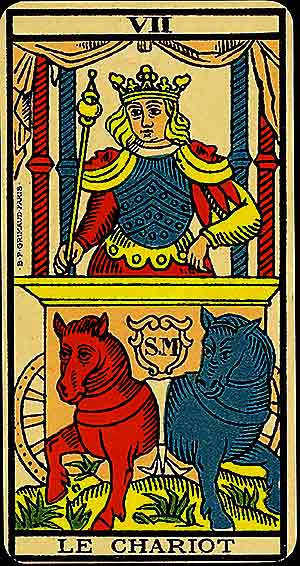 VII – The Chariot |
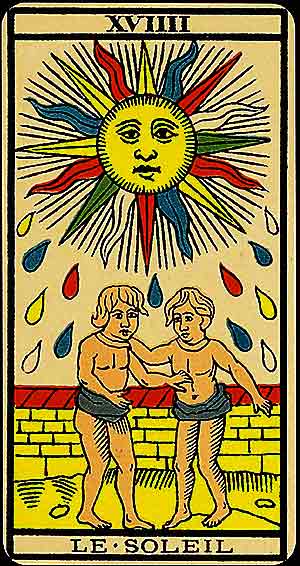 XVIIII – The Sun (Le Soleil) |
|
| Outcome if you don't do it: | |||
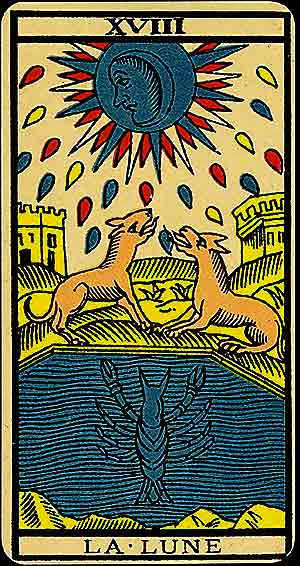 XVIII – The Moon (La Lune) |
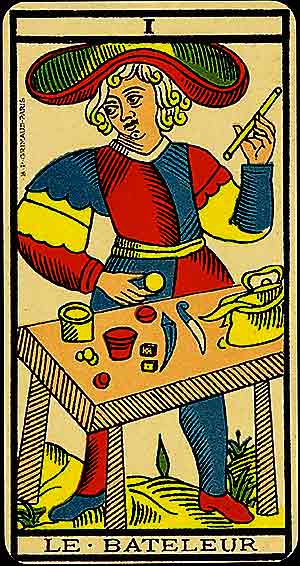 I – The Magician (Le Bateleur) |
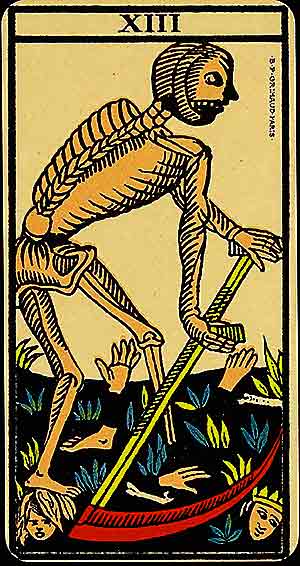 XIII – Death (La Mort) |
|

VIIII – The Hermit (L'Hermite)
The Hermit represents solitude, introspection, and the pursuit of inner wisdom. He invites the seeker to retreat from distractions and focus on the guiding light within.
Symbolism: An old man walks with a staff, holding a lantern that illuminates his path. The lantern symbolises the light of wisdom gained through introspection and experience. His posture suggests humility and patience, while his cloak emphasises withdrawal from the external world.
In Relationships: A period of self-reflection or a need for solitude to gain clarity on emotional matters.
In Work: A time for careful planning and introspection. Wisdom lies in patient deliberation rather than immediate action.
Spiritually: The Hermit invites the seeker to turn inward, embracing solitude as a space for spiritual awakening and self-discovery.
When ill-dignified: Isolation, fear of introspection, or excessive withdrawal. It warns against cutting oneself off from others or resisting inner truth.
Outcome if you do it:

XXI – The World (Le Monde)
The World is the culmination of the journey, representing fulfilment, harmony, and unity. It signifies the integration of all aspects of life and the successful completion of a cycle, opening the way to new beginnings.
Symbolism: A central figure dances within a laurel wreath, symbolising victory and wholeness. The four corners often depict symbolic creatures (the lion, ox, eagle, and man), representing the elements, the fixed signs of the zodiac, or the four faces of a cherubim. The wreath signifies completion and eternity.
In Relationships: A harmonious, complete relationship or fulfilment of long-term goals in love. It reflects unity and shared purpose.
In Work: The successful culmination of a project or phase. Recognition and achievement mark this time of completion.
Spiritually: Le Monde invites the seeker to embrace the interconnectedness of all things, celebrating unity with the divine and readiness for new journeys.
When ill-dignified: Incompletion, stagnation, or feeling unfulfilled despite external success. It warns against losing sight of the bigger picture or resisting closure.

VII – The Chariot
The Chariot represents triumph through willpower and discipline. It is the card of focused determination, suggesting the mastery of opposing forces to achieve a unified goal.
Symbolism: The charioteer stands tall, guiding two horses of contrasting colours, symbolising duality and control. The canopy above him evokes divine protection, while the wheels in motion reflect progress and momentum. His expression is resolute, embodying control amidst dynamic movement.
In Relationships: Moving forward together, overcoming challenges, or achieving harmony despite differences.
In Work: Success through focus, persistence, and strategic action. Victory is attainable through balance and self-control.
Spiritually: The Chariot teaches the alignment of inner and outer forces, calling for the integration of spirit and will to advance.
When ill-dignified: Lack of direction, recklessness, or internal conflict. It warns against being pulled in opposing directions without clarity of purpose.

XVIIII – The Sun (Le Soleil)
The Sun represents joy, success, and clarity. It is the card of illumination and vitality, promising growth, harmony, and the fulfilment of goals through clarity and connection.
Symbolism: Two children stand joyfully under the radiant Sun, surrounded by a protective wall. The Sun itself symbolises divine energy and enlightenment, while the figures reflect innocence, unity, and shared happiness. The vibrant rays evoke abundance and the thriving life force.
In Relationships: Mutual happiness, harmony, and a joyful connection. Relationships flourish under the light of clarity and love.
In Work: Success and recognition achieved through positivity and effort. It suggests a time of clarity and accomplishment.
Spiritually: The Sun calls for embracing the light within and aligning with your true purpose, radiating joy and love outward.
When ill-dignified: Arrogance, burnout, or overexposure. It warns against taking blessings for granted or letting ego overshadow gratitude.
Outcome if you do not do it:

XVIII – The Moon (La Lune)
The Moon symbolises intuition, mystery, and the subconscious. It reflects the realm of dreams, illusions, and emotions, inviting you to explore the depths of your psyche and confront hidden truths.
Symbolism: The Moon casts its dim light over a mysterious scene: a dog and a wolf howl beneath its glow, representing the duality of tame and wild instincts. A crayfish emerges from the water, symbolising the hidden depths of the subconscious rising to the surface. The two towers suggest boundaries between reality and the unknown.
In Relationships: Emotional complexity, hidden dynamics, or the need to trust your intuition. Beware of illusions or misunderstandings.
In Work: A period of uncertainty or unclear direction. It encourages careful reflection and trusting inner instincts over external noise.
Spiritually: The Moon calls for introspection and exploration of the shadow self through dreams, intuition, and subconscious symbols.
When ill-dignified: Confusion, deception, or fear of the unknown. It warns against being lost in illusions or succumbing to anxiety.

I – The Magician (Le Bateleur)
The Magician represents skill, potential, and the power to shape reality. As the first step in the Major Arcana, he symbolises the individual's awareness of their tools and the initiation of personal mastery.
Symbolism: The table before him holds simple tools—a cup, a coin, a blade, and a wand—representing the raw elements of life and their mastery. His wide-brimmed hat, resembling the lemniscate, speaks of infinite potential and dynamic creativity. The uneven terrain below mirrors his capacity to balance uncertainty with control.
In Relationships: A time to take initiative or charm your way into new connections. The Magician highlights personal magnetism but warns against manipulation.
In Work: A signal to harness your skills and capitalise on emerging opportunities. Confidence and action are key.
Spiritually: The Magician is the bridge between spirit and matter, teaching you to use divine gifts responsibly.
When ill-dignified: Deception, arrogance, or scattered energy. It warns against using talents for selfish or destructive ends.

XIII – Death (La Mort)
Death signifies transformation, endings, and renewal. While often feared, this card speaks to the cyclical nature of life and the necessity of clearing away the old to make way for the new.
Symbolism: A skeletal figure wields a scythe, cutting through the remnants of the past—hands, heads, and plants alike. The barren ground reflects the stripping away of what no longer serves, while the sprouting flowers hint at rebirth and growth emerging from decay.
In Relationships: The end of a relationship or a transformative phase within one. It signals profound changes, often for the better.
In Work: A major shift, such as the end of a job or the restructuring of goals. It's a call to embrace new opportunities.
Spiritually: Death teaches the power of release and the necessity of embracing life's cycles to achieve transformation.
When ill-dignified: Fear of change, stagnation, or clinging to the past. It warns against resisting the natural process of renewal.